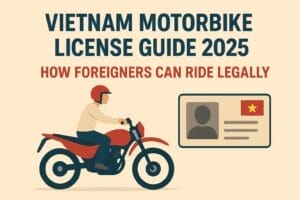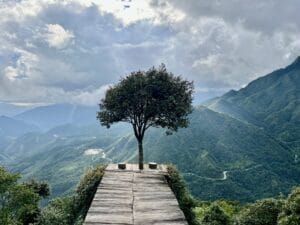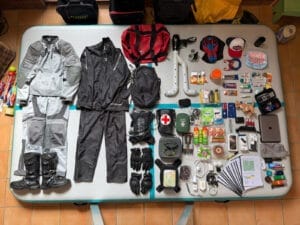Northern Vietnam Dirt Bike Tour to Ta Xua, Dien Bien Phu, Sapa & Hagiang | Mr Chai Chua & friends
Vietnam Motorbike Tour to Laos – Travel Guide:
1. Overview of Vietnam & Laos:
1.1. Vietnam – A Land of Timeless Beauty and Rich Culture
Vietnam, a Southeast Asian gem, is a nation that captivates travelers with its timeless beauty, rich culture, and captivating history. From the stunning landscapes to the vibrant cities, Vietnam offers an unparalleled tapestry of experiences that beckon adventurers and culture enthusiasts alike.
1.1.1. A Country of Mesmerizing Landscapes
Vietnam’s natural beauty is a testament to its diversity. From the towering peaks of the northern highlands to the picturesque coastline along the South China Sea, the country’s landscapes are nothing short of mesmerizing.
+ Sapa’s Lush Rice Terraces: The terraced rice fields of Sapa in the far north create a breathtaking mosaic of green. This region, often shrouded in mist, is home to various ethnic tribes, making it an ideal place to explore local culture.
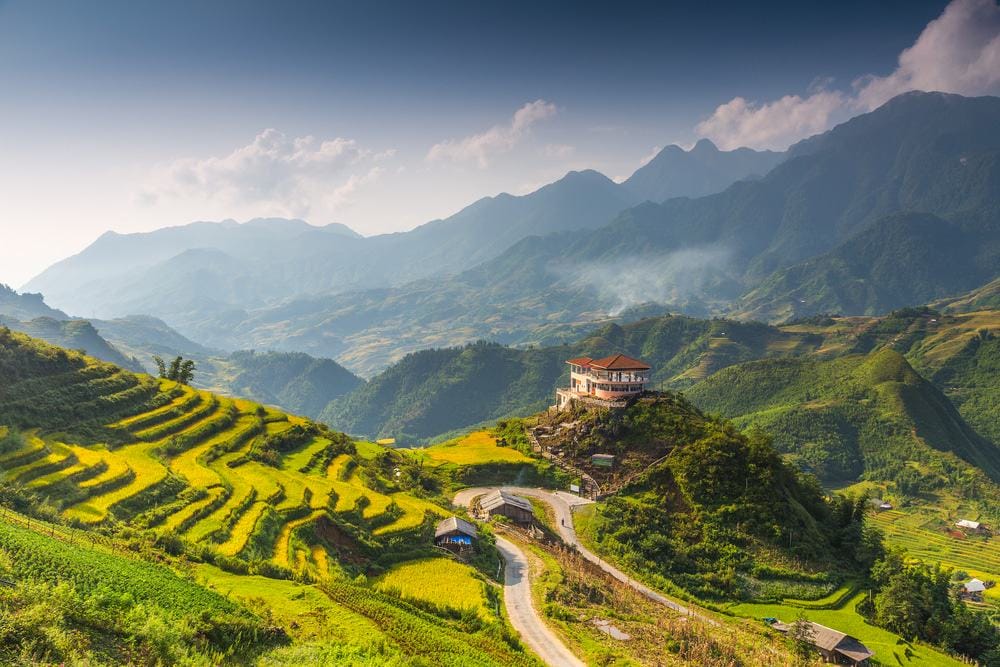
+ Halong Bay’s Mystical Islands: Halong Bay is a UNESCO World Heritage Site with its iconic limestone karsts rising dramatically from emerald waters. A cruise through these mystical islands is a must.
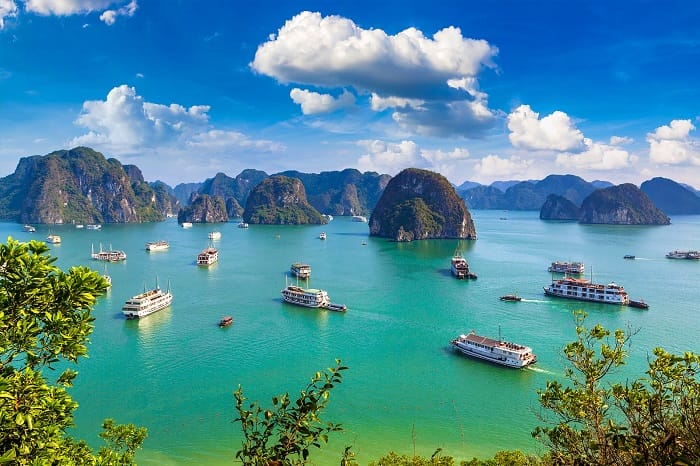
+ Mekong Delta’s Waterworld: In the southern Mekong Delta, life revolves around water. Traditional villages, floating markets, and an intricate network of waterways offer a glimpse into a unique way of life.
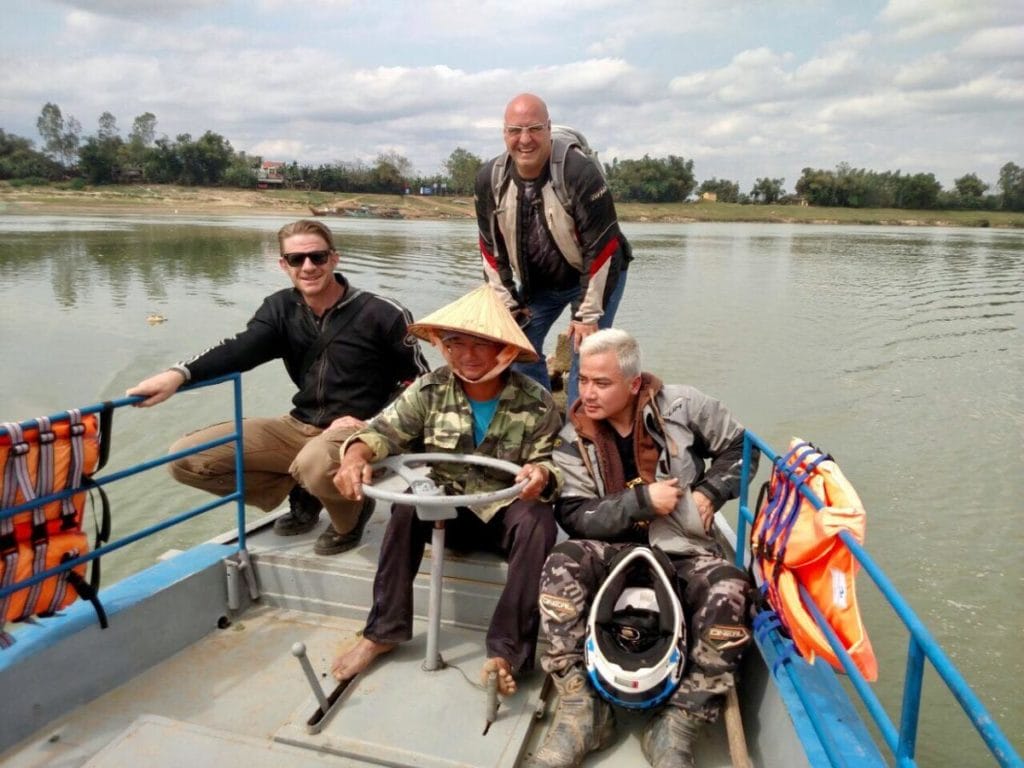
+ Central Vietnam’s Beaches: The central coast of Vietnam boasts pristine beaches such as My Khe and An Bang, making it an ideal destination for relaxation and watersports.
+ Dalat’s Highland Charms: The cool highland town of Dalat is known for its romantic scenery, with rolling hills, flower gardens, and the picturesque Xuan Huong Lake.
1.1.2. A Cultural Kaleidoscope
Vietnam’s cultural tapestry is woven with the threads of tradition, history, and diversity. From ancient temples to bustling markets, the country’s rich culture is on full display.
+ Hanoi’s Old Quarter: Hanoi, the capital, is a blend of ancient and modern. Its Old Quarter is a maze of narrow streets filled with street vendors, traditional architecture, and lively markets.
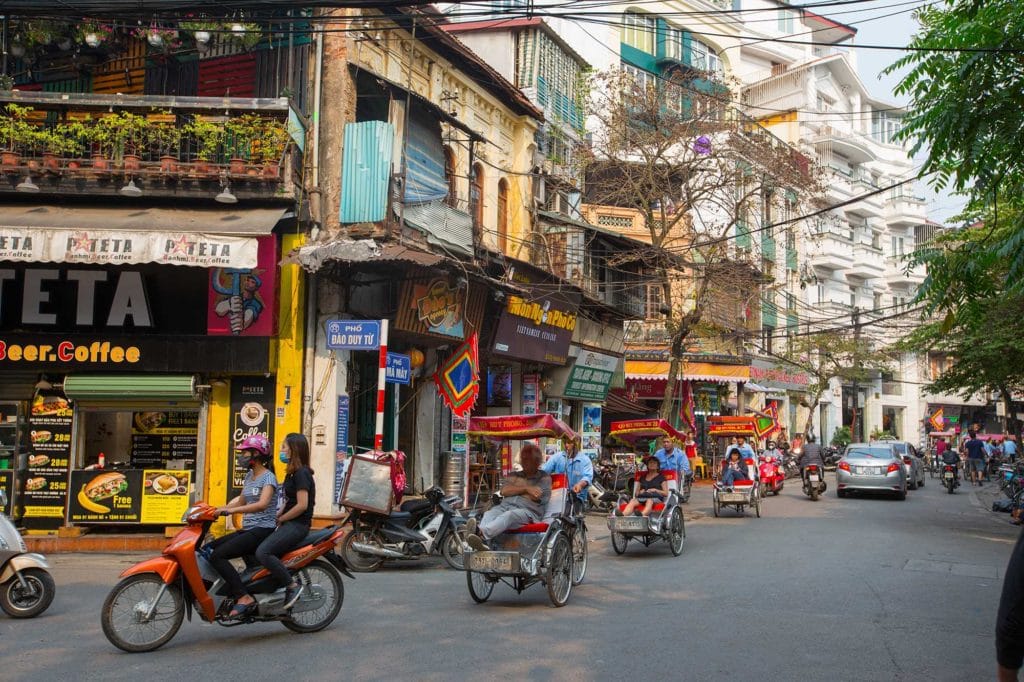
+ Hue’s Imperial Legacy: The former imperial city of Hue is a living museum of Vietnam’s royal past, with its ancient citadel, royal tombs, and intricate pagodas.
+ Hoi An’s Ancient Beauty: The charming town of Hoi An, a UNESCO World Heritage Site, is renowned for its well-preserved ancient architecture, lantern-lit streets, and tailor shops.
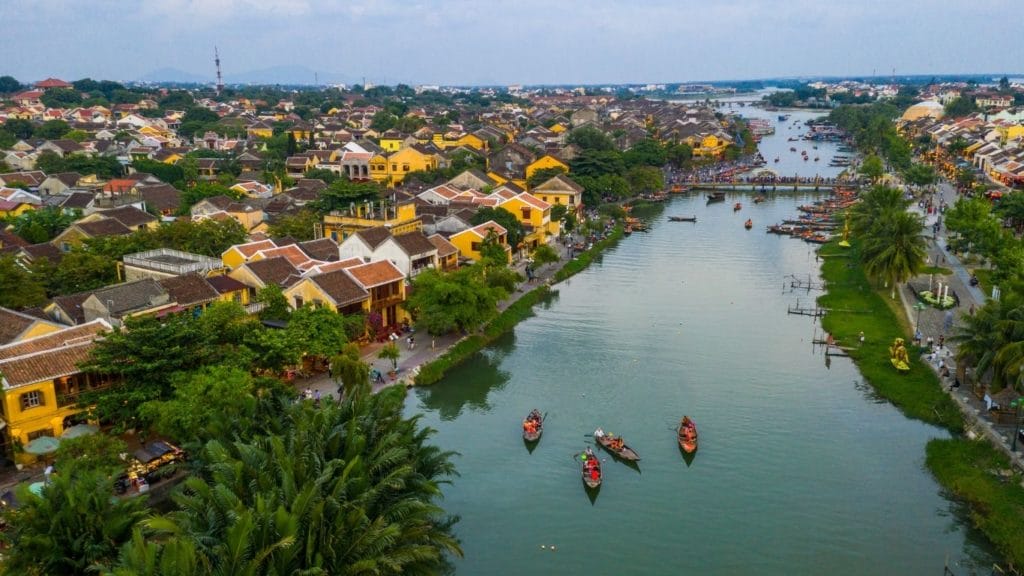
+ Ho Chi Minh City’s Bustling Energy: Ho Chi Minh City, formerly Saigon, is a bustling metropolis with a vibrant street food scene, French colonial architecture, and modern skyscrapers.
Hill Tribe Culture: In the northern highlands, the country is home to numerous ethnic minority groups, each with its own unique customs and traditions.
1.1.3. Culinary Adventures
Vietnamese cuisine is celebrated worldwide for its fresh ingredients, bold flavors, and aromatic herbs. From street food stalls to fine dining restaurants, the food culture is a culinary adventure in itself.
+ Pho: A bowl of steaming pho, a traditional noodle soup, is a must-try. It’s the quintessential Vietnamese dish, with regional variations.
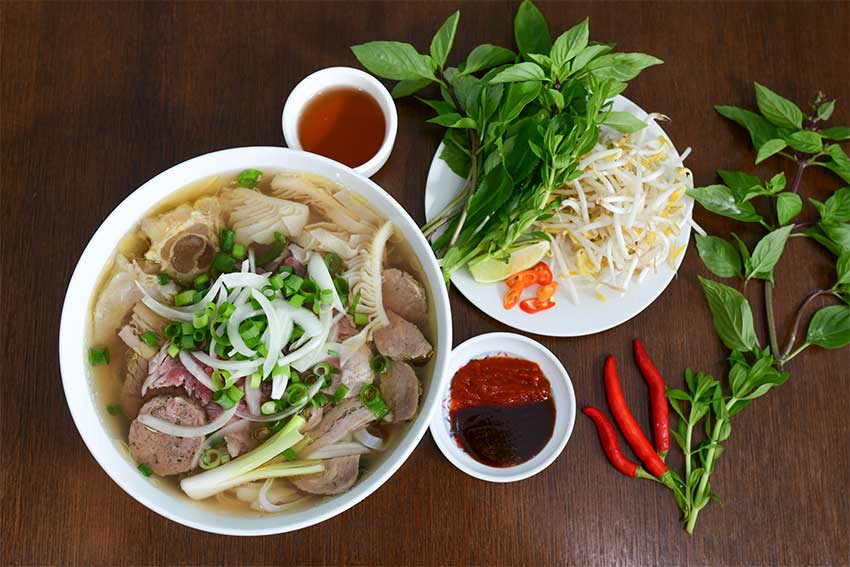
+ Banh Mi: The banh mi sandwich is a fusion of French baguettes and Vietnamese flavors. It’s a tasty and convenient snack found all over the country.
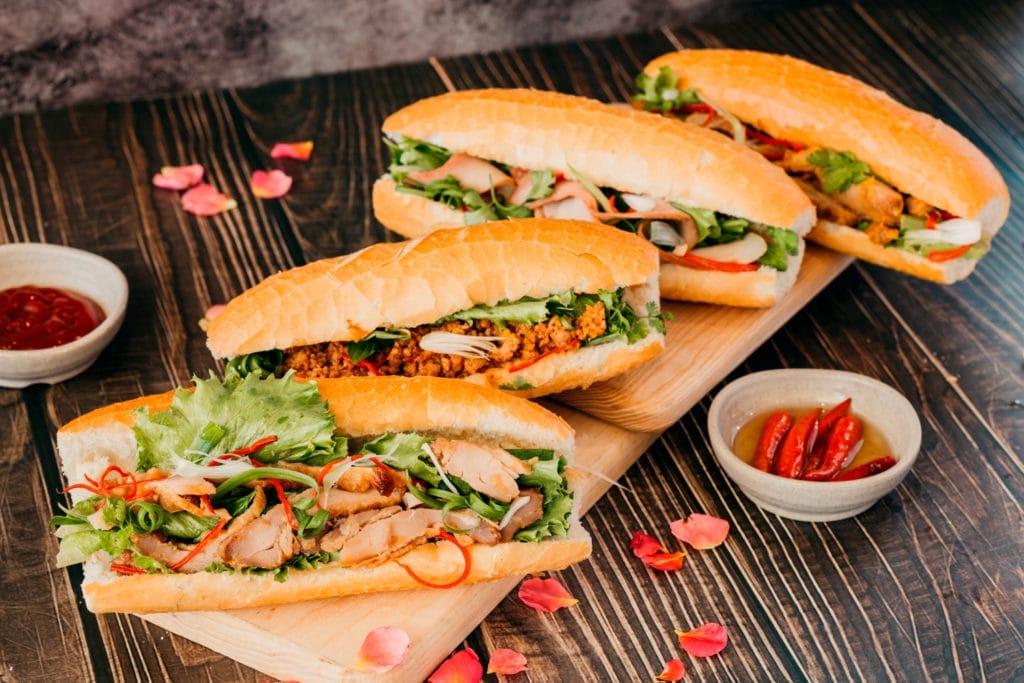
+ Spring Rolls: Vietnamese spring rolls come in various forms, both fried and fresh. They are typically filled with shrimp, herbs, pork, rice vermicelli, and other ingredients.
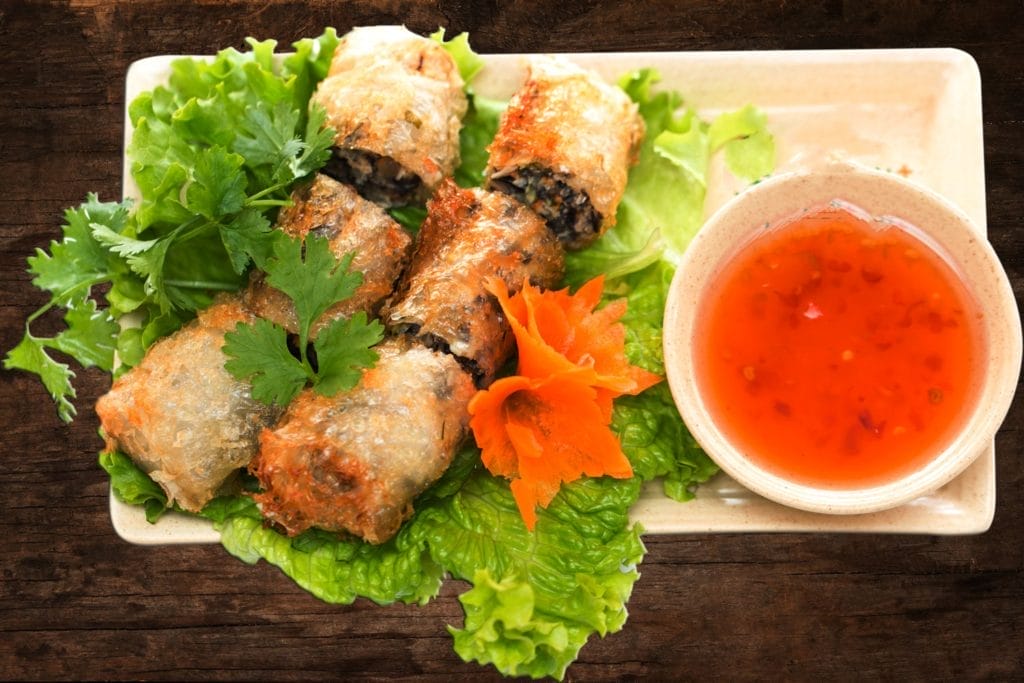
+ Coffee Culture: Vietnam is known for its strong and rich coffee. Don’t miss the traditional drip coffee or the iconic egg coffee.
1.1.4. A Complex History
Vietnam’s history is marked by periods of struggle and resilience. Visitors can explore historical sites and museums that offer insights into the nation’s past.
+ Cu Chi Tunnels: The Cu Chi Tunnels near Ho Chi Minh City were a vital part of the underground network used by the Viet Cong during the Vietnam War. Today, they are a popular historical attraction.

+ War Remnants Museum: Located in Ho Chi Minh City, this museum provides a stark portrayal of the Vietnam War through photographs and artifacts.
+ Imperial Citadel of Thang Long: This ancient citadel in Hanoi is a UNESCO World Heritage Site and offers a glimpse into Vietnam’s imperial history.
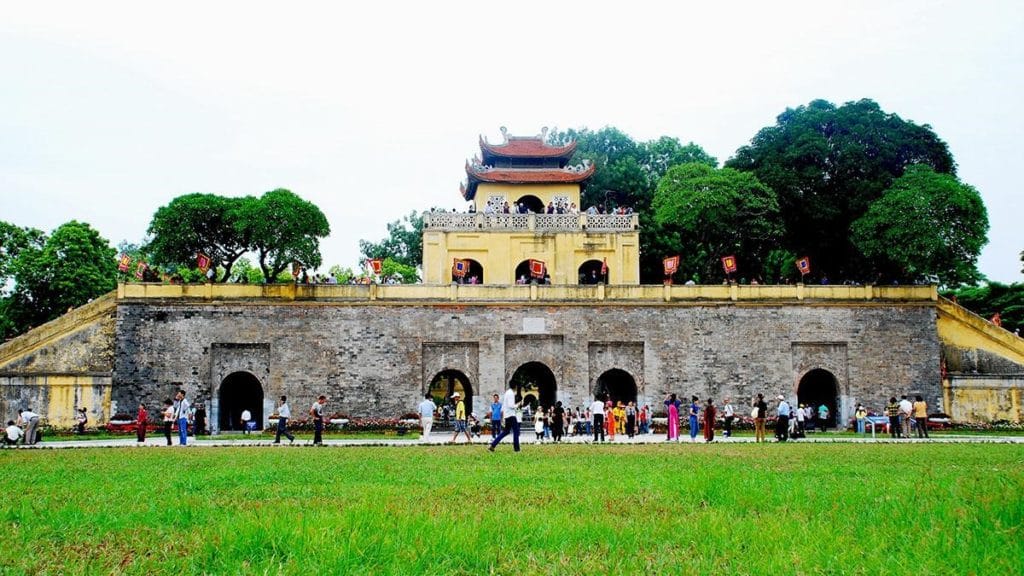
1.1.5. Adventurous Activities
For adventure seekers, Vietnam offers a range of activities to get the adrenaline pumping:
+ Vietnam Motorcycle Tours: The country’s winding roads and diverse landscapes make it a haven for motorcycle enthusiasts.
+ Trekking and Hiking: From the mountains of Sapa to the forests of Phong Nha – Ke Bang National Park, there are ample trekking opportunities.
+ Water Sports: Coastal regions offer fantastic opportunities for water activities like kayaking, snorkeling, and windsurfing.
+ Caving: Vietnam is home to some of the world’s largest caves, with Son Doong Cave being the most famous.
+ Cycling: The country’s scenic routes are perfect for cycling adventures, whether through rural villages or coastal roads.
1.1.6. Warm Hospitality
The Vietnamese people are known for their warmth and hospitality. Interactions with locals can be a highlight of any visit. Whether you’re sharing a meal at a street food stall or staying with a local family in a homestay, you’ll likely be welcomed with open arms.
1.1.7. A Land of Contrasts
Vietnam is a country of stark contrasts, where ancient traditions meet modernity, bustling cities are surrounded by serene landscapes, and historical sites stand side by side with contemporary culture.
Vietnam is a captivating destination that offers a blend of natural beauty, cultural richness, and diverse experiences. It’s a land where history and tradition are intertwined with modernity, and where every journey reveals something special. Whether you’re exploring its mountains, coasts, or cities, Vietnam is a place where the past and the present coexist in harmonious contrast, creating a tapestry of unforgettable moments for all who visit.
1.2. Laos: The Serene Jewel of Southeast Asia
Nestled in the heart of Southeast Asia, Laos, often referred to as the “Land of a Million Elephants,” is a serene and enchanting country that seems to have transcended time. With its lush landscapes, rich cultural heritage, and warm hospitality, Laos is a destination that beckons travelers seeking a tranquil escape from the fast-paced modern world.
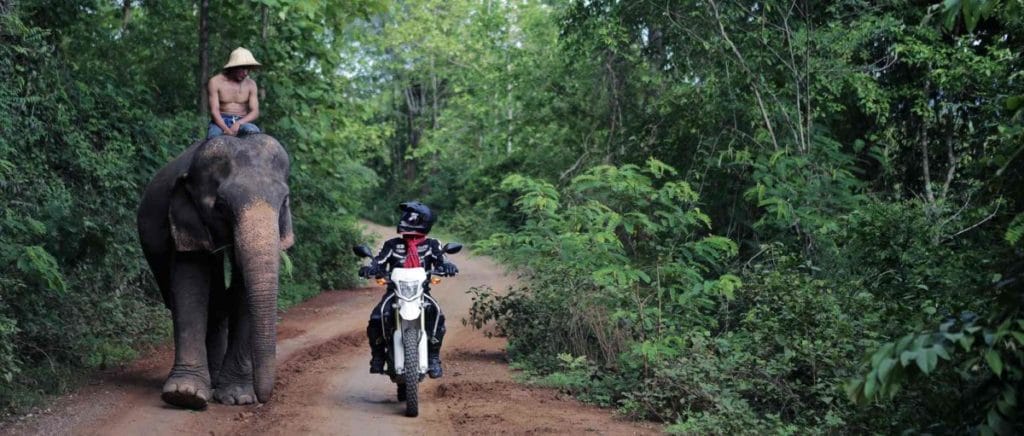
1.2.1. The Scenic Canvas of Nature
Laos boasts a stunning natural canvas, offering a pristine environment that has been largely untouched by the rapid development seen in neighboring countries. Here are some of the natural wonders that make Laos a sanctuary for nature lovers:
+ Majestic Mekong River: The mighty Mekong River, often referred to as the “Mother of Waters,” flows through Laos, shaping its landscapes. Cruising along this river allows you to witness traditional life along its banks and explore remote villages.
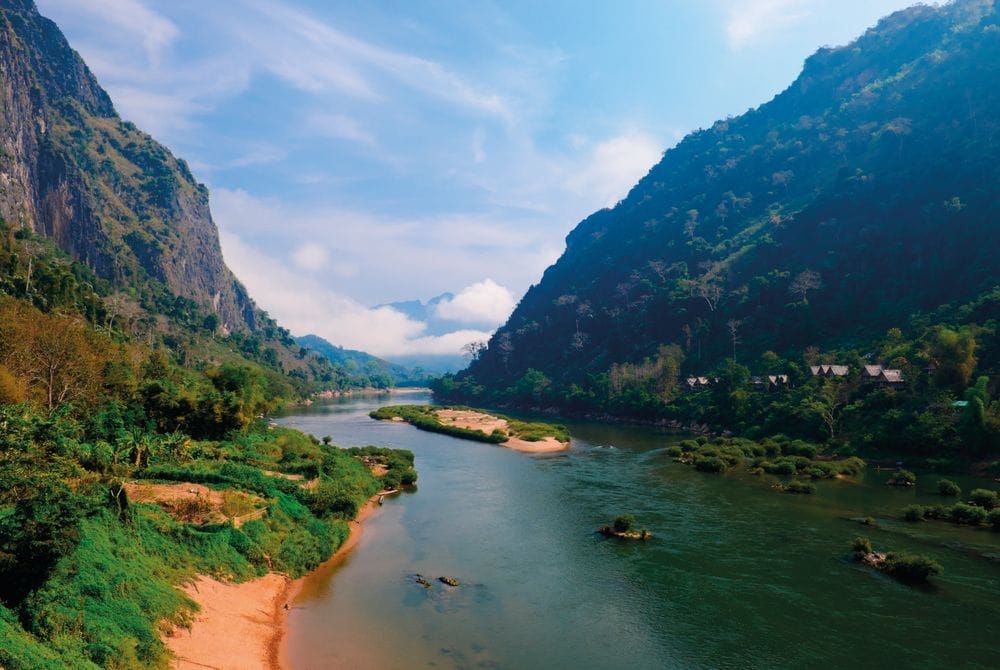
+ Lush Jungle and National Parks: From the lush jungles of Bokeo Nature Reserve to the dramatic limestone karsts of Vang Vieng, Laos is home to a wealth of national parks and protected areas. These are ideal for trekking, birdwatching, and encountering diverse wildlife.
Cascading Waterfalls: Laos is dotted with enchanting waterfalls, such as Kuang Si Falls and Tad Fane Waterfall. The turquoise waters of these cascades offer a refreshing escape from the tropical heat.
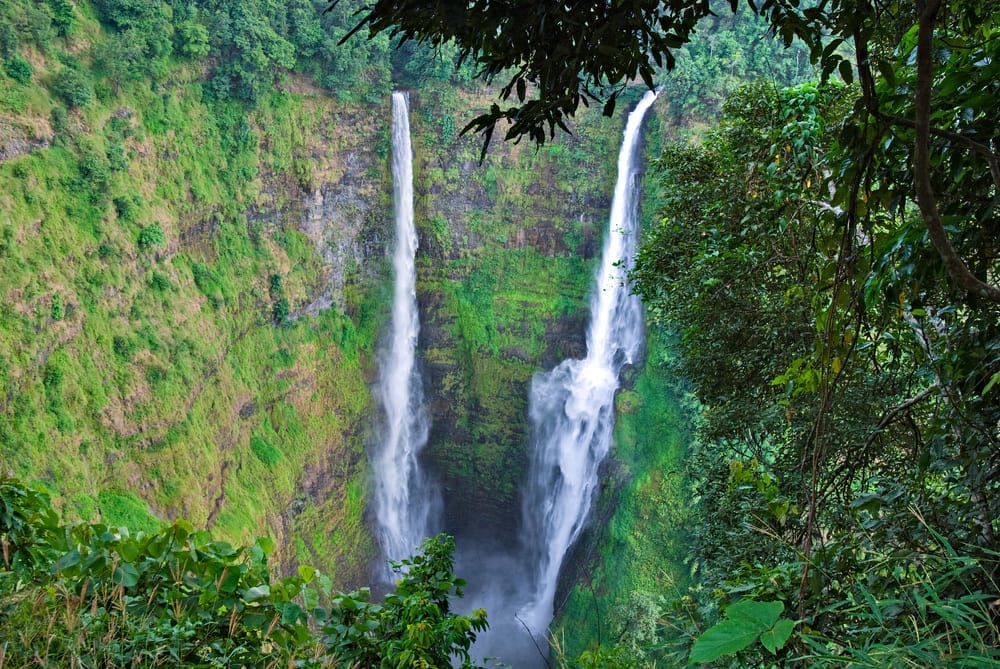
Rice Terraces: The northern province of Muang Ngoi is renowned for its stunning rice terraces that cascade down the mountainside. It’s a landscape that reflects the hard work and artistry of the local farmers.
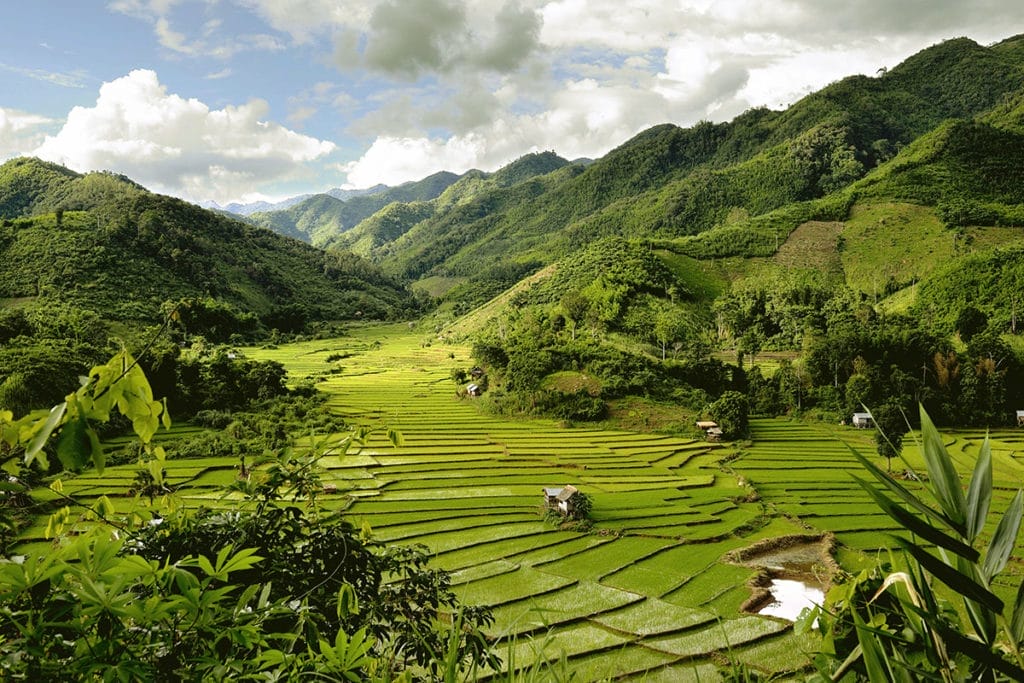
Cave Systems: Laos is home to some of the world’s most extensive cave systems. Tham Kong Lor, known as the “Kong Lor Cave,” is a mesmerizing seven-kilometer-long cave where you can take a boat trip through a subterranean world.
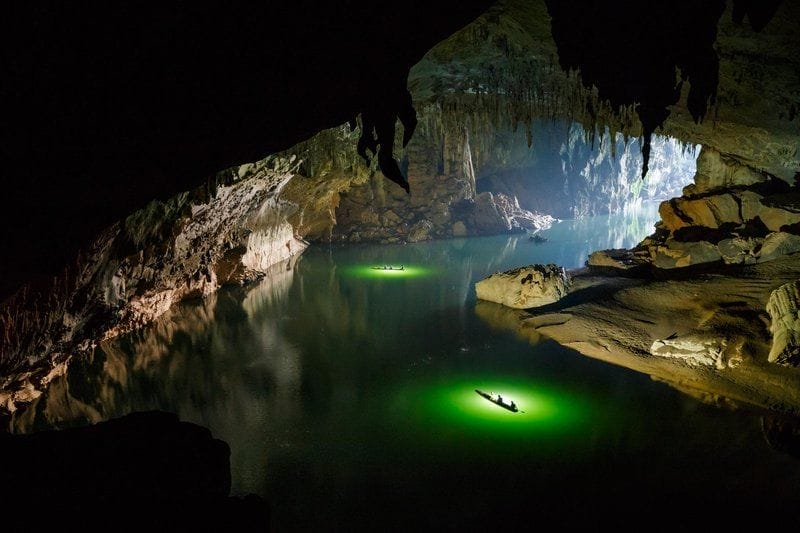
1.2.2. A Cultural Tapestry
Laos is a treasure trove of cultural heritage, with a strong emphasis on Buddhism, traditional crafts, and ancient rituals. Here are some cultural highlights:
+ Buddhist Temples and Monasteries: The city of Luang Prabang, a UNESCO World Heritage Site, is renowned for its well-preserved temples and monasteries. The daily alms-giving ceremony is a spiritual experience to witness.
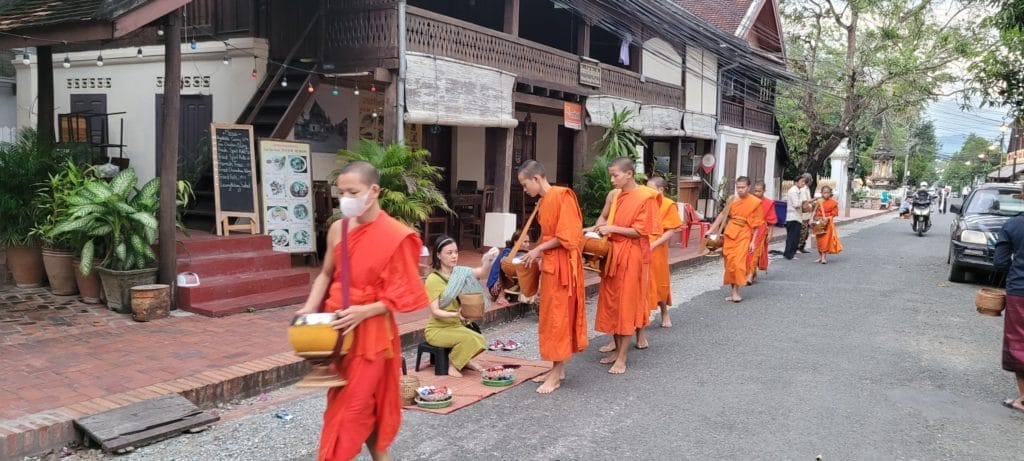
+ Traditional Crafts: Laos is famous for its traditional crafts, including intricate silk weaving, pottery, and woodcarving. Visiting local workshops provides a glimpse into these ancient traditions.
+ Ethnic Diversity: The country is home to numerous ethnic minority groups, each with its own customs and languages. Exploring their villages allows you to connect with their unique cultures.
+ Festivals: Laos celebrates various festivals throughout the year, often associated with Buddhism and local traditions. The Boat Racing Festival and Boun Pi Mai (Lao New Year) are among the most vibrant.
+ Ancient Ruins: The mysterious Plain of Jars is scattered with ancient stone jars of unknown origin, shrouded in legend and history. These archaeological sites offer a sense of intrigue and exploration.
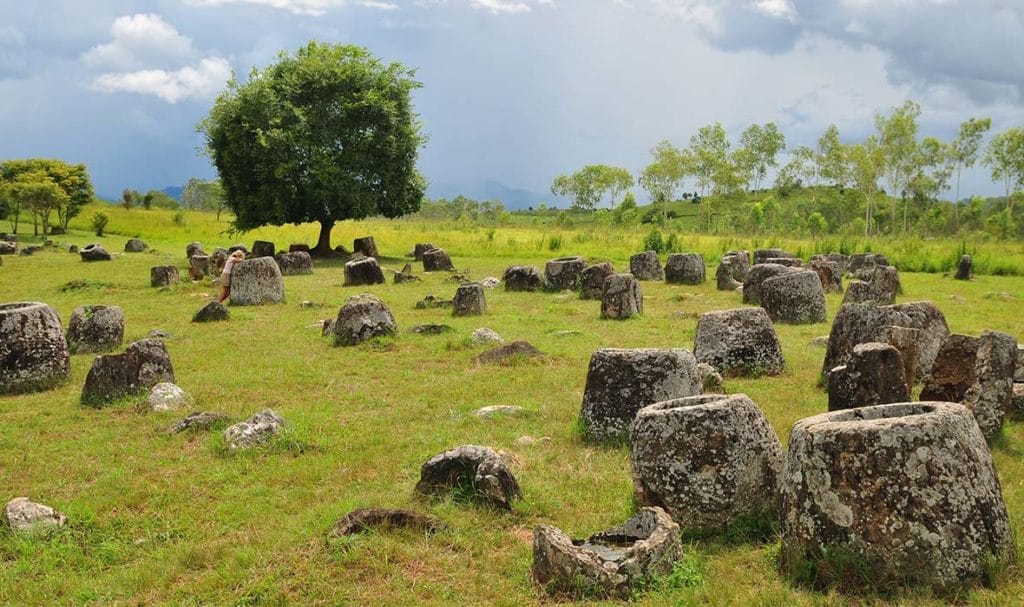
1.2.3. Warm Hospitality
Laotians are known for their genuine and warm hospitality. The people are friendly, welcoming, and eager to share their culture with visitors. Whether you’re enjoying a meal in a local village or participating in a traditional ceremony, you’ll feel like an honored guest.
1.2.4. Culinary Adventures
Lao cuisine is a delightful blend of flavors and ingredients that reflects the country’s agricultural abundance. Traditional Lao dishes incorporate fresh herbs, vegetables, and an array of spices. Here are some culinary highlights:
+ Sticky Rice: Lao people have a deep love for sticky rice, and it’s a staple of nearly every meal. It’s often enjoyed with various dips and dishes.
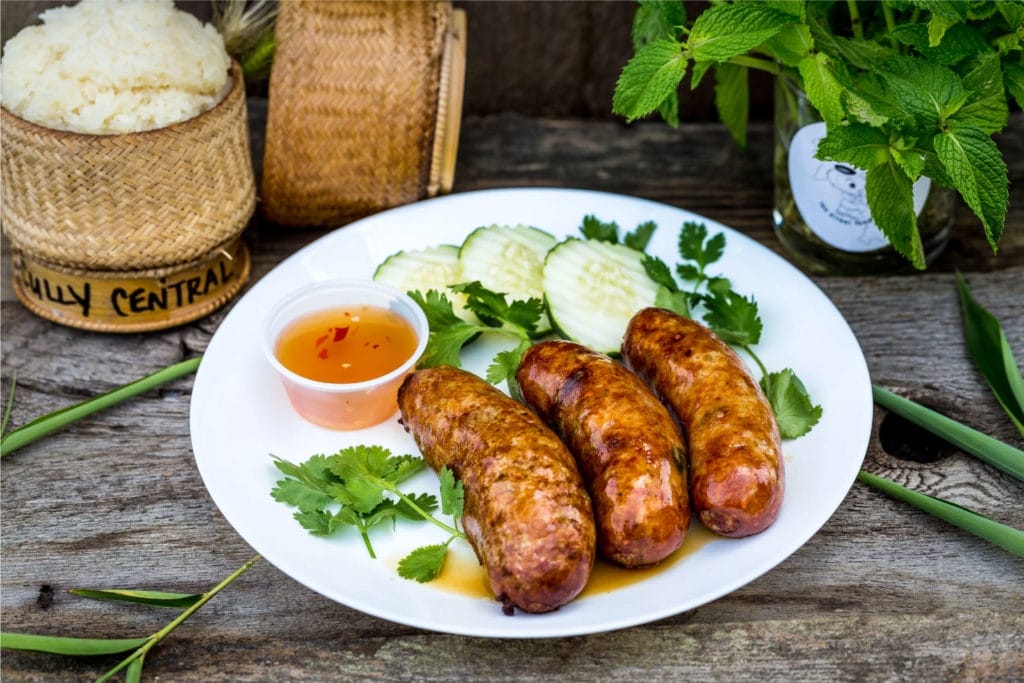
+ Larb: A savory minced meat salad, larb is a quintessential Lao dish. It’s made with minced meat (often chicken or fish), herbs, lime, and chilies.
+ Tam Mak Hoong: Also known as green papaya salad, this dish is a spicy and tangy combination of shredded papaya, lime, fish sauce, and chili.
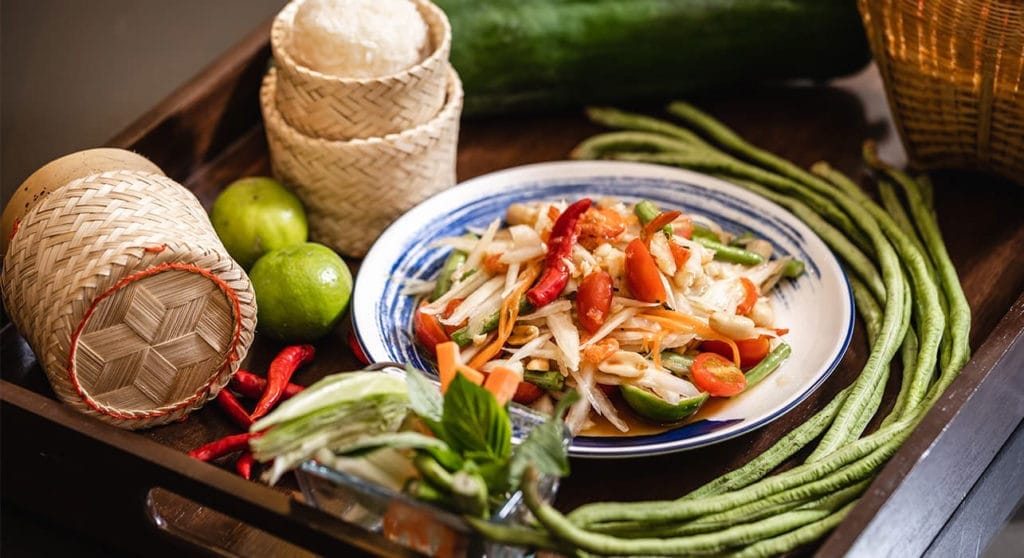
+ Mok Pa: Mok Pa is a fragrant dish made by wrapping fish in banana leaves with a mixture of herbs and spices and steaming it to perfection.
+ Khao Poon: This flavorful noodle soup features a coconut-based broth and is served with an array of fresh herbs and vegetables.
1.2.5. A Tranquil Escape
One of the defining characteristics of Laos is its peaceful and laid-back atmosphere. Unlike the bustling metropolises of some neighboring countries, Laos offers a chance to slow down and appreciate the simple pleasures of life. Whether you’re sipping coffee at a riverside café in Vientiane or exploring the serene temples of Luang Prabang, you’ll feel a sense of tranquility that’s both refreshing and restorative.
1.2.6. Adventures and Exploration
For those seeking adventure, Laos offers a wealth of opportunities:
+ Trekking and Hiking: The country’s lush jungles, mountains, and remote villages provide countless trekking opportunities.
+ Cycling: The scenic roads and rural landscapes are perfect for cyclists. The Bolaven Plateau is a popular cycling destination.
+ River Activities: The Mekong River and its tributaries offer the chance for river adventures, including kayaking and tubing.
+ Cave Exploration: With an extensive cave network, Laos is a paradise for cave explorers. Tham Kong Lo and Tham Poukham are among the must-visit cave systems.
+ Elephant Encounters: The Elephant Conservation Center in Sayaboury offers an ethical and educational experience with elephants.
1.2.7. A Land of Contrasts
Laos is a land of harmonious contrasts. It blends the serenity of its natural landscapes with the vibrancy of its culture. It effortlessly marries tradition with modernity, and it’s a place where every corner reveals something extraordinary.
Laos is a hidden gem in Southeast Asia, a country that inspires wonder and appreciation for the beauty of simplicity. It’s a destination that invites you to connect with nature, immerse yourself in culture, and savor the sweetness of life at a more relaxed pace. Laos is not just a place to visit; it’s a place to be experienced and cherished.
2. How many border gates in between Vietnam and Laos can people ride motorcycles through?
There are several border crossings, also known as border gates, between Vietnam and Laos where people can ride motorcycles through. Here are some of the major border crossings that allow motorcycle travel between the two countries:
2.1. Tay Trang Border Gate (Vietnam) – Na Meo Border Gate (Laos):
This border crossing is in the northern part of Vietnam, near the town of Dien Bien Phu. It provides access to the northern regions of Laos.
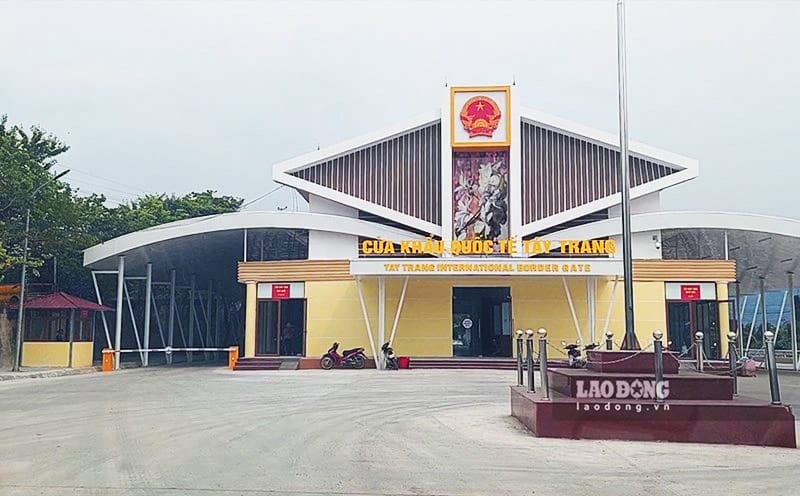
2.2. Nam Can Border Gate (Vietnam) – Nam Khan Border Gate (Laos):
Located in Nghe An Province of Vietnam, this border crossing connects to the province of Bolikhamxay in Laos.
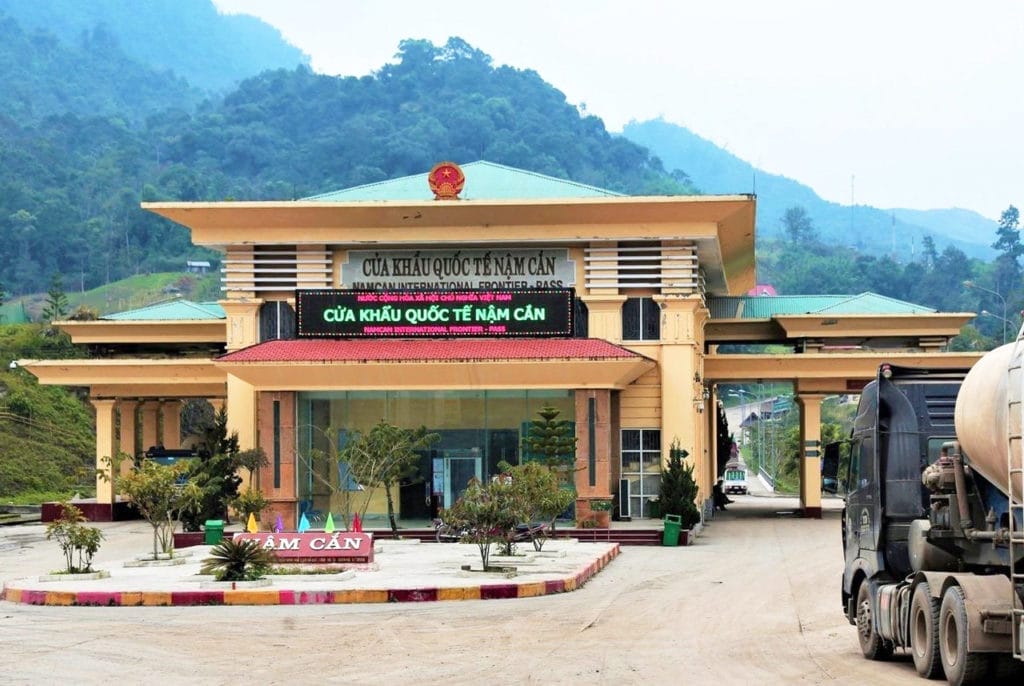
2.3. Lao Bao Border Gate (Vietnam) – Densavanh Border Gate (Laos):
Situated in Quang Tri Province in Vietnam, this border crossing leads to Savannakhet Province in Laos.
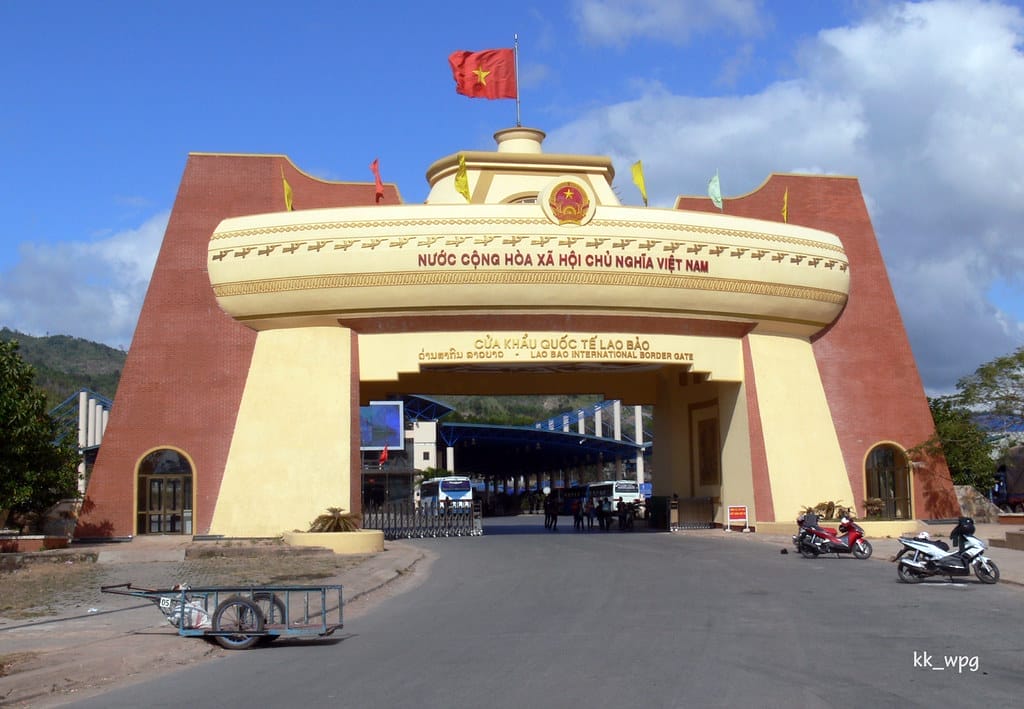
2.4. Bo Y Border Gate (Vietnam) – Ngoc Hoi Border Gate (Laos):
This border crossing is in Kon Tum Province, Vietnam, and connects to Attapeu Province in Laos.
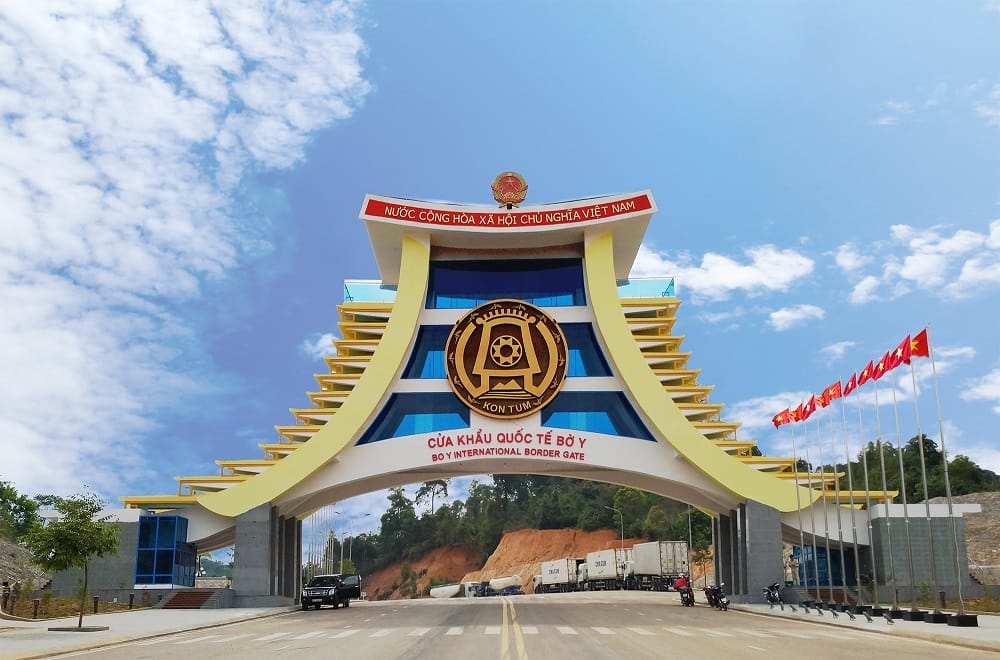
2.5. Cau Treo Border Gate (Vietnam) – Nam Phao Border Gate (Laos):
Located in Ha Tinh Province, Vietnam, this border crossing provides access to Khammouane Province in Laos.
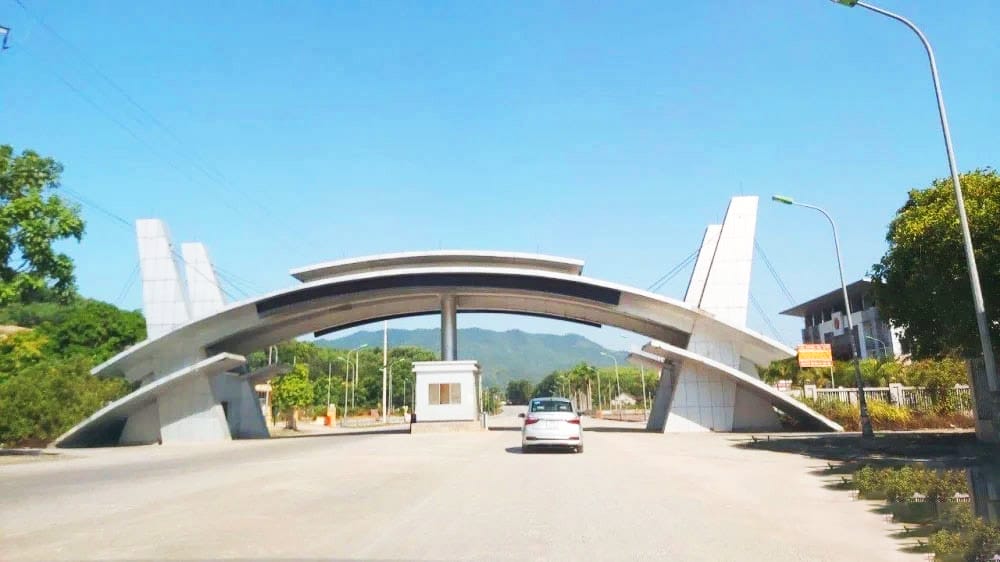
2.6. Lao Cai Border Gate (Vietnam) – Hekou Border Gate (Laos):
In the northernmost part of Vietnam, this border crossing connects to the town of Boten in Laos.
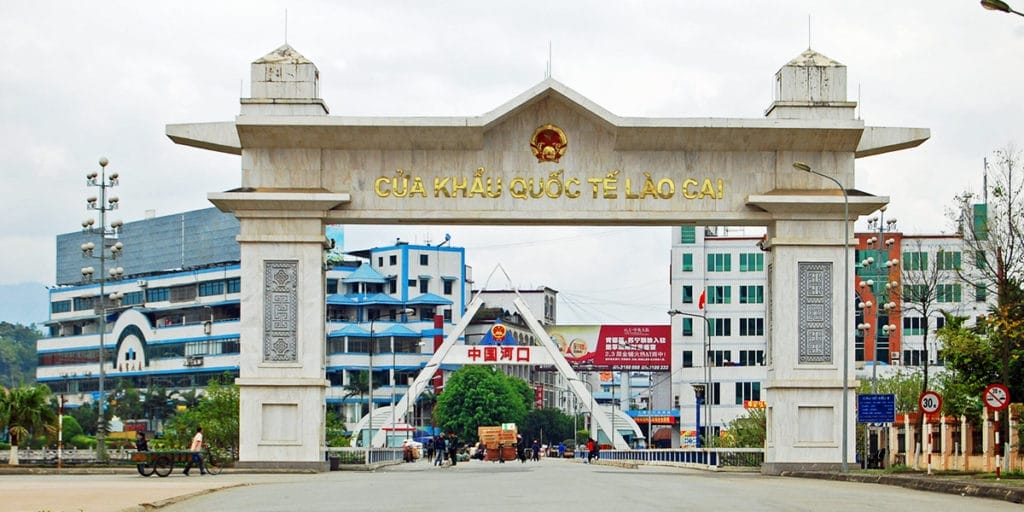
These border crossings vary in terms of accessibility and the specific regulations and requirements for crossing, so it’s important to check the current conditions and entry requirements before planning a motorcycle journey between Vietnam and Laos. Additionally, some border gates may have restrictions on the types of vehicles allowed to cross, so it’s advisable to verify the latest information with relevant authorities or embassies before your trip.
3. Why should people take a cross-border motorbike tour from Vietnam to Laos or vice versa?
Picture this: A cool breeze ruffling your hair, the faint scent of exotic flowers in the air, and endless vistas of lush green mountains. If you’re an adventurous soul seeking an extraordinary experience, a cross-border motorbike tour from Vietnam to Laos might just be your next epic journey. In this article, we’re going to delve into the captivating reasons why you should consider embarking on this unforgettable adventure.
3.1. The Enchanting Scenery
Laos, the Land of a Million Elephants, boasts some of the most breathtaking landscapes in Southeast Asia. From serene rivers and waterfalls to towering limestone karsts and thick rainforests, this country is a haven for nature enthusiasts. As you embark on your cross-border motorbike tour from Vietnam, you’ll witness the dramatic shift in scenery, from the bustling streets of Hanoi to the tranquil villages of Laos. The journey itself is a feast for the eyes, with opportunities to snap Instagram-worthy photos around every corner.
3.2. A Taste of Authenticity
One of the most rewarding aspects of a cross-border motorbike tour is the opportunity to immerse yourself in local cultures. Laos, a nation known for its friendly people and preserved traditions, offers an authentic experience that’s hard to find in more touristy destinations. You’ll have the chance to interact with locals, savor delicious street food, and learn about the rich history of Laos. From exploring hidden temples to participating in traditional ceremonies, this journey promises an abundance of cultural experiences.
3.3. Epic Road Trips
If you’re a fan of road trips, this cross-border adventure is tailor-made for you. The roads that connect Vietnam to Laos are a testament to the natural beauty of Southeast Asia. As you navigate your motorbike through winding mountain passes and serene valleys, you’ll come across remote villages and towns that are rarely visited by tourists. The thrill of conquering challenging terrains is a reward in itself.
3.4. Delicious Food to Satisfy Your Taste Buds
Laos offers a unique culinary experience that is distinct from its neighboring countries. From aromatic soups like “khao poon” to the popular “laap” (minced meat salad), the flavors of Laotian cuisine are sure to tantalize your taste buds. Plus, you’ll have the chance to try some bizarre but delicious snacks like crispy fried insects, a must-try for the adventurous foodie.
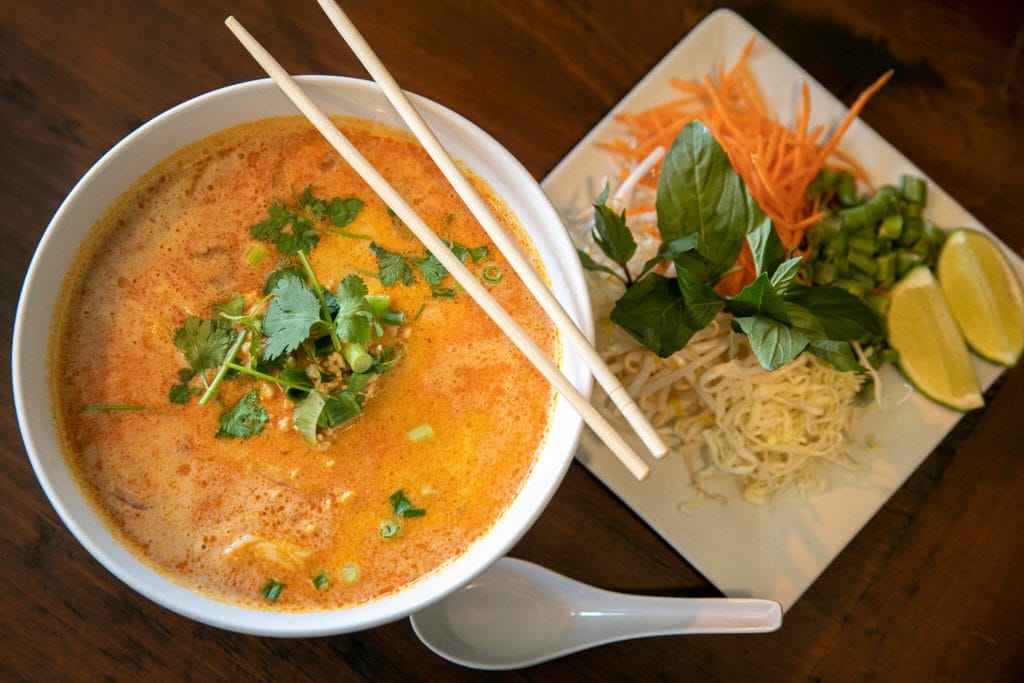
3.5. Affordable Adventure
Compared to many Western destinations, Southeast Asia offers exceptional value for your money. Your cross-border motorbike tour from Vietnam to Laos won’t break the bank. Accommodations, food, and transportation are all affordable, which allows you to extend your adventure without worrying about your budget.
3.6. Getting Off the Beaten Path
If you’re tired of overcrowded tourist spots and cliché destinations, a cross-border motorbike tour is your ticket to getting off the beaten path. Laos, in particular, has numerous hidden gems that are yet to be discovered by the masses. From the remote northern villages to pristine waterfalls tucked away in the jungle, you’ll find solitude and serenity.
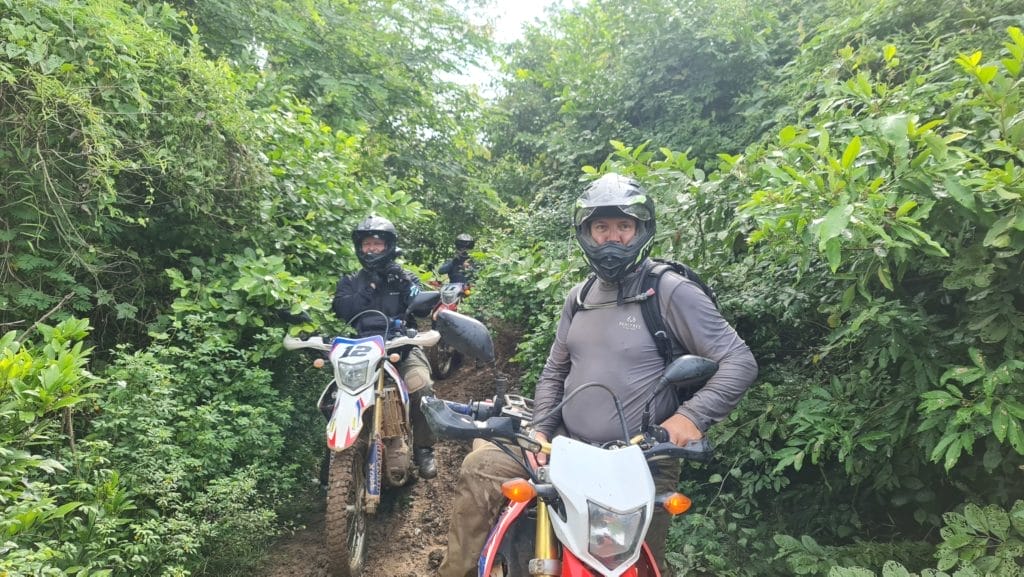
3.7. The Thrill of Adventure
Adventurers, this one’s for you! The thrill of riding a motorbike through the lush landscapes of Vietnam and Laos is an experience like no other. You’ll encounter hairpin turns, river crossings, and unpredictable weather conditions, which will keep your adrenaline pumping. Each twist and turn of the journey is a story waiting to be told.
3.8. The Warmth of the People
Laos is known for its warm and friendly locals who welcome travelers with open arms. Whether you need directions, want to strike up a conversation, or simply share a smile, you’ll find that the people you meet along the way add an extra layer of richness to your journey.
3.9. Unique Photography Opportunities
If you’re passionate about photography, this journey will provide an endless canvas of subjects to capture. From vibrant hill tribes in traditional attire to serene Buddhist temples, the photo opportunities are boundless.
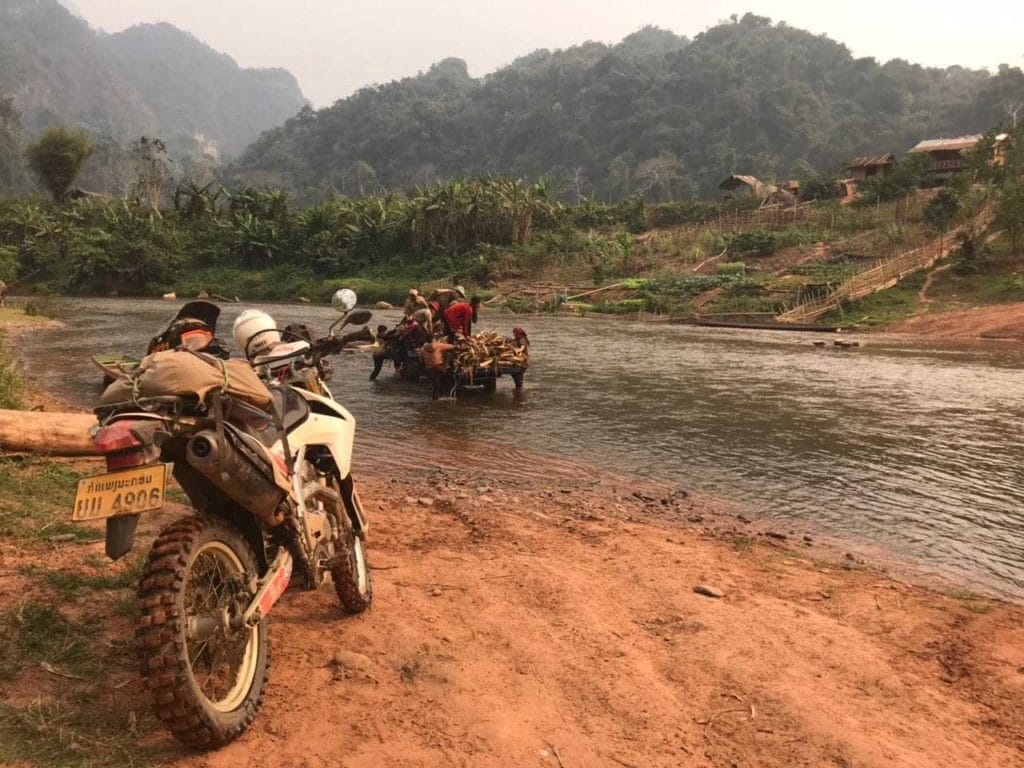
3.10. Cherished Memories
A cross-border motorbike tour from Vietnam to Laos isn’t just an adventure; it’s a journey that will create memories to last a lifetime. The challenges you overcome, the friendships you forge, and the breathtaking moments you experience will become cherished stories to share with friends and family.
In a world of crowded tourist destinations and predictable vacations, a cross-border motorbike tour from Vietnam to Laos is a breath of fresh air. It’s an adventure that combines the thrill of the open road, the richness of local culture, and the beauty of unspoiled landscapes. So, what are you waiting for? Grab your helmet, rev up your motorbike, and set out on an unforgettable journey through the enchanting landscapes of Vietnam and Laos.
Embark on this adventure, and you’ll discover why it’s the road less traveled that often leads to the most memorable experiences.
4. The Best Time to Ride Motorcycles Cross Borders from Vietnam to Laos
When it comes to embarking on an epic cross-border motorcycle journey from Vietnam to Laos, timing is everything. The weather, road conditions, and the overall experience can vary significantly based on the time of year you choose to hit the open road. In this comprehensive guide, we’ll delve into the best times to undertake this thrilling adventure, taking into account both safety and the kind of experience you’re seeking.
4.1. November to February – The Cool and Dry Season:
Advantages: This period is generally considered the best time for motorcycle tours. The weather is comfortably cool, with temperatures ranging from 15°C to 25°C (59°F to 77°F), making for pleasant riding conditions.
Advantages: Clear skies, minimal rainfall, and pleasant temperatures create perfect riding conditions. You’ll enjoy breathtaking scenery without sweltering heat.
Considerations: This is the peak tourist season in Laos, so accommodations may be in high demand, and prices could be higher.
4.2. March to April – The Transition Period:
Advantages: The transition period from March to April offers viable riding conditions. The landscape is lush from the previous rainy season, and the temperatures are warmer without being scorching.
Considerations: Be prepared for some heat, especially in the lowland areas.
4.3. May to October – The Rainy Season:
Advantages: During the wet season, which extends from May to October, the countryside is vibrant and green, with fewer tourists. This can be a unique experience for those who don’t mind rain and are prepared for wet roads.
Considerations: Riding during heavy rain can be challenging and less safe. Landslides and flooding may also impact the roads.
4.4. Consider the Route and Region:
The best time for your motorbike tour may also depend on the specific route you plan to take and the regions you intend to explore. Northern routes in Vietnam and Laos, with their mountainous terrain, may be more comfortable during the cooler and drier months, while southern routes can be navigated year-round.
4.5. Local Festivals and Events:
Check for local festivals and events along your route. Participating in cultural celebrations can add a unique dimension to your journey. Some festivals are held at specific times of the year and can enhance your experience.
4.6. Weather Patterns:
It’s important to research the weather patterns in both Vietnam and Laos, as they can vary by region. Inquire about the typical weather conditions for the specific places you plan to visit.
4.7. Road Conditions:
Road conditions can also vary depending on the time of year. Heavy rain can lead to slippery and muddy roads in some areas, so be aware of the conditions for your chosen route.
In conclusion, the best time for tourists to ride motorbikes from Vietnam to Laos is typically during the cool and dry season from November to February. However, the transition period in March and April can also offer favorable conditions. The rainy season from May to October is an option for those seeking a unique experience but involves some challenges. Ultimately, the timing of your journey should align with your weather preferences and your willingness to adapt to the road conditions in different regions along the route. Always check the latest weather forecasts and road conditions before embarking on your motorbike adventure.
4.8. Packing and Preparation for All Seasons
No matter when you decide to embark on your cross-border motorcycle journey, there are essential preparations and packing tips to keep in mind:
4.8.1 Riding Gear:
Ensure you have appropriate riding gear for varying weather conditions, including helmets, jackets, pants, gloves, and boots. Waterproof gear can be invaluable during the rainy season.
4.8.2 Maintenance:
Keep your motorcycle in top condition, with regular maintenance and a pre-trip checkup. Ensure your tires are suitable for the season.
4.8.3 Navigation:
Invest in a reliable GPS device or smartphone app for navigation. Have paper maps as backups.
4.8.4 Emergency Kit:
Carry a well-equipped first-aid kit and tools for basic motorcycle repairs. Additionally, include spare parts like spark plugs, fuses, and a tire repair kit.
4.8.5 Luggage:
Choose waterproof luggage to protect your gear and clothing from rain.
4.8.6 Travel Insurance:
Consider travel insurance that covers medical emergencies, motorcycle accidents, and trip interruptions, especially during the wet season.
4.9. The Best Time Is When You’re Ready
Ultimately, the best time to ride motorcycles cross borders from Vietnam to Laos depends on your preferences, tolerance for weather conditions, and the type of adventure you seek. Whether you choose the cool and dry season for comfortable riding or the rainy season for a unique experience, be prepared, stay safe, and embrace the elements. Your cross-border journey promises to be an unforgettable adventure, regardless of the timing.
Note: Always check the latest travel advisories, border crossing regulations, and weather forecasts before planning your journey. Road conditions and border accessibility can change, so it’s essential to stay informed.
5. Who should be engaging such an adventure motorbike tour from Vietnam to Laos?
Engaging in an adventure motorbike tour from Vietnam to Laos is an exciting endeavor, but it’s essential to be well-prepared and aware of the challenges involved. This type of journey is best suited for certain individuals or groups with specific characteristics and preferences. Here are some considerations for who should be engaging in such a tour:
5.1. Experienced Motorcyclists:
Adventure motorbike tours involve riding on a variety of terrains, including mountain roads, rough paths, and sometimes in adverse weather conditions. It’s crucial to have prior motorcycling experience to handle these challenges safely.
5.2. Adventure Enthusiasts:
If you have a passion for exploration and a love of adventure, this type of tour can be a thrilling experience. It’s not just about riding; it’s about embracing the unknown and relishing the journey itself.
5.3. Fitness and Health:
Good physical health is essential for long days of riding and sometimes physically demanding activities such as trekking or hiking. Adequate stamina and strength are beneficial.
5.4. Group or Solo Travelers:
Both solo travelers and those who prefer to travel with a group can engage in this adventure. Group tours offer camaraderie, while solo travelers have the flexibility to create their itineraries.
5.5. Risk Tolerance:
Adventure motorbike tours can be unpredictable, and riders should have a reasonable risk tolerance. This includes dealing with uncertain road conditions, navigating remote areas, and being prepared for unexpected situations.
5.6. Adventure Tour Operators:
Some travelers may prefer to join organized adventure tour operators that provide support vehicles, guides, and pre-planned itineraries, which can be helpful for those with less motorcycling experience.
5.7. For those who are open-minded & Respect to Local Cultures:
Adventure motorbike tours often lead to encounters with new people, cuisines, and cultures. An open-minded approach allows for a richer and more immersive experience. And Travelers should show respect for the local cultures they encounter. Learning about and appreciating the customs and traditions of the places you visit enhances the experience.
5.8. For those who are capable of finance
Travelers should have a budget in place that covers all expenses, including accommodations, meals, fuel, maintenance, and any emergency situations. Proper financial planning is key.
In summary, adventure motorbike tours from Vietnam to Laos are best suited for individuals or groups who are physically fit, have prior motorcycling experience, and possess a spirit of adventure. A well-prepared and open-minded approach is essential for making the most of this incredible journey through diverse landscapes and cultures.
6. How to prepare for a flawless Vietnam Motorbike Tour to Laos?
There’s something undeniably alluring about the idea of riding your motorcycle through picturesque landscapes, venturing beyond borders, and experiencing the thrill of the open road. For those seeking an adventure like no other, a cross-border motorcycle journey from Vietnam to Laos promises to be an unforgettable experience. In this comprehensive guide, we’ll walk you through the ins and outs of making this thrilling trip a reality.
Chapter 1: Preparing for the Journey – Vietnam Motorbike Tour to Laos
Before you hit the road, it’s crucial to make the necessary preparations. From visa requirements to selecting the right motorcycle, here’s what you need to know:
1.1 Visa Requirements
First and foremost, you’ll need to ensure that you have the appropriate visas to enter both Vietnam and Laos. Visa requirements can vary based on your nationality, so it’s essential to check with the respective embassies or consulates for up-to-date information. Generally, tourists can obtain visas on arrival for both countries, but it’s best to confirm this before your journey.
1.2 Choosing the Right Motorcycle
Selecting the right motorcycle is a critical step. It’s recommended to use a reliable, well-maintained motorcycle with a robust engine for this journey. Many travelers prefer dirt bikes or dual-sport motorcycles, which are well-suited for varying terrains. Ensure your motorcycle is in top condition, with a thorough check-up and maintenance before you set out.
1.3 Necessary Documents
You’ll need to carry important documents with you, including your passport, motorcycle registration, and any relevant insurance papers. Make sure to keep photocopies and digital backups of these documents, just in case. Additionally, an International Driving Permit (IDP) is often required to legally ride in both Vietnam and Laos.
Chapter 2: Route Planning – Vietnam Motorbike Tour to Laos
Route planning is where the adventure begins. Let’s explore how to chart your course from Vietnam to Laos:
2.1 The Classic Route: Hanoi to Luang Prabang
One of the most popular routes for a cross-border motorcycle journey is from Hanoi, the capital of Vietnam, to Luang Prabang, a charming town in northern Laos. This route offers a blend of bustling cities and serene countryside.
2.2 Alternative Routes
If you’re seeking a more off-the-beaten-path adventure, consider alternative routes that will take you to less touristy areas. Options include starting from Hanoi and heading east towards Dien Bien Phu, then crossing the border to Muang Khua, Laos, and continuing southward.
2.3 Detailed Itinerary
Creating a detailed itinerary is crucial for a successful journey. Plan your stops, accommodation, and rest days. Take into account the road conditions, weather, and your riding capabilities when setting daily goals.
Chapter 3: Safety First
Safety should be your top priority on any motorcycle journey. Here are some safety tips to keep in mind:
3.1 Riding Gear
Invest in high-quality riding gear, including a DOT-approved helmet, riding jacket, pants, gloves, and riding boots. Proper gear will not only protect you in case of an accident but also shield you from the elements.
3.2 Motorcycle Maintenance
Regular maintenance is essential to ensure your motorcycle remains in good working condition throughout the journey. Pay attention to tire pressure, brakes, engine, and all vital components.
3.3 First Aid Kit
Carry a well-equipped first aid kit, which includes bandages, antiseptic, pain relievers, and any necessary prescription medications.
3.4 Emergency Contacts
Make a list of emergency contacts, including local authorities and the nearest embassies or consulates in case you need assistance.
3.5 Travel Insurance
Consider getting travel insurance that covers medical emergencies and motorcycle accidents. It’s a safety net that can provide peace of mind.
Chapter 4: Packing Essentials
When preparing for your cross-border motorcycle journey, packing wisely is a key element. Here’s a breakdown of what you should consider:
4.1 Clothing
Pack clothing suitable for different weather conditions, as the climate can vary along the route. Include rain gear, warm layers, and breathable garments for hot days. Don’t forget extra socks and underwear.
4.2 Camping Gear
If you plan to camp along the way, bring essential camping gear like a lightweight tent, sleeping bag, and cooking equipment. However, if you decide to take a guided trip through a travel agency, all your worries will be left behind
4.3 Tools and Spare Parts
Carry a basic toolkit for motorcycle repairs, as well as spare parts such as spark plugs, fuses, and a tire repair kit. These can save you in case of breakdowns.
4.4 Navigation
A reliable GPS device or a smartphone with an offline maps app is invaluable for navigation. Carry a paper map as a backup.
4.5 Personal Items
Don’t forget your toiletries, sunscreen, insect repellent, and any personal items you need.
Chapter 5: Crossing Borders – Vietnam Motorbike Tour to Laos
Crossing international borders with your motorcycle requires careful planning and adherence to regulations:
5.1 Border Crossings
Research the specific border crossings you’ll use and their operating hours. Some crossings may be closed on certain days, so plan your journey accordingly.
5.2 Entry and Exit Procedures
When approaching the border, follow the entry and exit procedures for each country. You may need to fill out customs and immigration forms, show your documents, and pay any required fees.
5.3 Import and Export Permits
Ensure you have the necessary permits to temporarily import and export your motorcycle. These documents typically include a “temporary vehicle importation” permit for both countries.
5.4 Customs Regulations
Familiarize yourself with customs regulations, as certain items, especially those subject to high taxes or duties, may need to be declared.
Chapter 6: Cultural Etiquette
Understanding and respecting local cultures is an essential part of a memorable journey:
6.1 Language
Learn some basic phrases in the local languages. This small effort can go a long way in fostering positive interactions with locals.
6.2 Dress Code
Respect dress codes, especially when visiting religious sites. In many parts of Laos, it’s appropriate to cover your shoulders and knees.
6.3 Local Customs
Be mindful of local customs and traditions. For example, it’s customary to remove your shoes when entering someone’s home in Laos.
Chapter 7: Accommodation and Dining – Vietnam Motorbike Tour to Laos
Accommodation and dining options can greatly enhance your journey:
7.1 Accommodation
From budget-friendly hostels to luxury resorts, you’ll find a range of accommodation options along your route. Booking in advance is advisable, especially during peak travel seasons.
7.2 Dining
Savor local cuisine by trying street food stalls, local restaurants, and traditional dishes. Food is an integral part of the cultural experience.
Chapter 8: Money Matters
Managing your finances during your journey is crucial. Here’s how to handle money while riding from Vietnam to Laos:
8.1 Currency Exchange
Both Vietnamese Dong and Laotian Kip are the primary currencies in their respective countries. It’s wise to carry some local currency, as well as US dollars, which are widely accepted for larger expenses.
8.2 ATMs
ATMs are readily available in.
———————————————————————————–
To get more details on many other Cross-Border Motorbike Tours from Vietnam to Laos, you can visit here. Otherwise, you can see more our best Vietnam Motorbike Tours and Laos Motorbike Tours.
Of course, you can also follow us at this following youtube channel to see what we’re doing for our guests:
https://www.youtube.com/@indochinamotorbiketours

